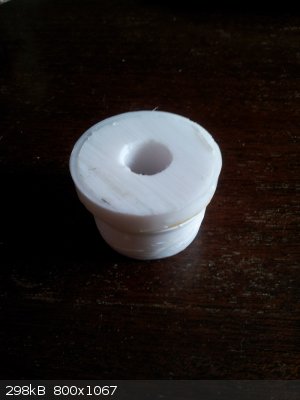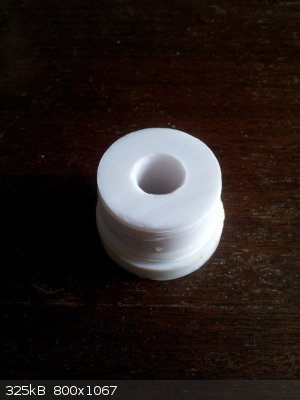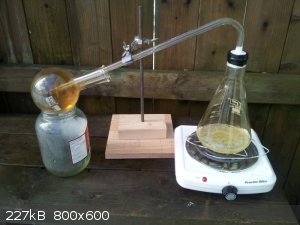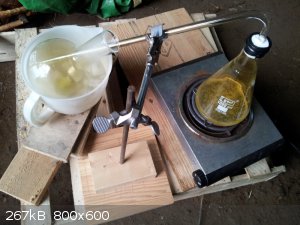| Pages:
1
..
17
18
19 |
experimenter
Harmless

Posts: 19
Registered: 7-11-2010
Member Is Offline
Mood: No Mood
|
|
Ammonium pyrosulfate: (NH4)2S2O7 (ref pyrosulfate)
Ammonium persulfate: (NH4)2S2O8 (ref http://en.wikipedia.org/wiki/Ammonium_persulfate)
Anyway, I don't think I need to mess with them. I will just try to decompose the salt that remains after the distillation inside sulfuric acid and see
what happens.
I already have done the NH4NO3 + sulfuric acid distillation (which by the way seems to run smoothly even without vacuum) and left with the icy,
stone-like salt. It melts easily.
|
|
|
hissingnoise
International Hazard
    
Posts: 3940
Registered: 26-12-2002
Member Is Offline
Mood: Pulverulescent!
|
|
| Quote: | | I will just try to decompose the salt that remains after the distillation inside sulfuric acid and see what happens. |
Well, good luck with that . . .
|
|
|
experimenter
Harmless

Posts: 19
Registered: 7-11-2010
Member Is Offline
Mood: No Mood
|
|
| Quote: |
Well, good luck with that . . . |
Thanks!
Just tried it, it doesn't work. I couldn't detect any ammonia evolving either by nose or by ph paper before the decomposition of the sulfuric acid.
|
|
|
hissingnoise
International Hazard
    
Posts: 3940
Registered: 26-12-2002
Member Is Offline
Mood: Pulverulescent!
|
|
See! Seeee! I told you it wouldn't work, didn't I; Didn't I? Oh but would you listen? Would you???
No! You had to go and be an experimenter.    
|
|
|
experimenter
Harmless

Posts: 19
Registered: 7-11-2010
Member Is Offline
Mood: No Mood
|
|
Hehe, yeea! 
I'm an experimenter, can't help it... 
|
|
|
hissingnoise
International Hazard
    
Posts: 3940
Registered: 26-12-2002
Member Is Offline
Mood: Pulverulescent!
|
|
One should discard all advice out-of-hand without, however, giving the impression the decision was taken lightly . . .
|
|
|
Zinc
Hazard to Others
  
Posts: 472
Registered: 10-5-2006
Member Is Offline
Mood: No Mood
|
|
Does anyone know how much water should be added to a AN/H2SO4 mix so that azeotropic HNO3 can be distilled from the mix instead of the conc. HNO3?
I think perhaps if the amount of AN/H2SO4 is what is required to produce 100 g of HNO3, 32g of water should be added?
|
|
|
Rosco Bodine
Banned
Posts: 6370
Registered: 29-9-2004
Member Is Offline
Mood: analytical
|
|
Distilling azeotropic nitric from H2SO4 + NH4NO3 or other nitrates, is a good process for making use of cheap battery electrolyte as the contributor
of needed water, to reduce the requirement for use exclusively of concentrated H2SO4, thereafter diluted with H2O. To find the theoretical minimum
requirement of water
for producing the 68% HNO3 azeotrope, first multiply the theoretical grams of pure HNO3 expected from a given mixture by the reciprocal of 0.68, (
which is 1.47 ) subtracting the weight of the expected weight of pure HNO3 from the product to give the minimum required H2O.
For example:
For a balanced reaction equation expected to produce 100 grams pure HNO3
100 X 1.47 = 147 = (total weight of 68% azeotrope produced) - 100 (total weight of pure HNO3 contained in the 147 grams of azeotrope) = 47 grams
(total H2O contained in the 147 grams of azeotrope)
In reality a bit in excess of the theoretical requirement of H2O will actually be needed and a bit in excess of the theoretical requirement of H2SO4
also,
with respect to theory based upon nitrate, and the initial distillate of HNO3
will be more concentrated than the azeotrope, but the distillate will gradually rise in temperature towards the azeotrope which will be the largest
fraction.
|
|
|
Funkerman23
Hazard to Others
  
Posts: 416
Registered: 4-1-2012
Location: Dixie
Member Is Offline
Mood: No Mood
|
|
Only thing that is missing from this thread is the kitchen sink..Still..If Nitric acid will react with platinum and gold( albeit very very slowly)
then at what rate will it attack borosilicate glass?
[Edited on 6-3-2012 by Funkerman23]
|
|
|
Bot0nist
International Hazard
    
Posts: 1559
Registered: 15-2-2011
Location: Right behind you.
Member Is Offline
Mood: Streching my cotyledons.
|
|
From a practical standpoint, nothing observed. I have stored RFNA in boro for quite some time, and never had problems at all. My distillation gear
used in its synthesis is also good as new.
U.T.F.S.E. and learn the joys of autodidacticism!
Don't judge each day only by the harvest you reap, but also by the seeds you sow.
|
|
|
CaliusOptimus
Hazard to Self
 
Posts: 96
Registered: 10-6-2011
Member Is Offline
Mood: Subjectively Objective
|
|
Just wanted to share my recent experience with RFNA purification:
500mL RFNA distilled from 98% tech H2SO4 and oven-dried KNO3 was placed into 1000mL RBF. Gas dispersion tube in one neck, condenser (-10c) on another.
Condenser was connected to a gas adapter>NaOH wash bottle>outside. Tech grade compressed O2 was fed through dispersion tube for 8 hours while
the RBF was warmed to 50C. I didn't notice any loss of color from the starting acid, in fact I'd say it got darker.
Next day I hooked a fish tank pump to the gas dispersion tube, with a 12" long 3/4" ID CaCl2 drying tube spliced in the line. In a matter of ~8 hours
the acid went from dark red to water white. I've come to the conclusion that my acid was too anhydrous to run pure O2 and expect results. I figure
that whatever water made it past the CaCl2 tube must have been enough to facilitate the reaction.
I won't be wasting any more O2, and I may not even dry the nitrate again. Both things have seemed to draw out the process with no real benefit.... but
I should probably titrate my HNO3 before I say any more.
[Edited on 22-1-2013 by CaliusOptimus]
|
|
|
Hennig Brand
International Hazard
    
Posts: 1284
Registered: 7-6-2009
Member Is Offline
Mood: No Mood
|
|
Cheap and Effective Nitric Acid Distillation Apparatus
Here is a very simple little glass still I made a year or so ago from common flasks without ground glass joints. The most important part of the
apparatus is the Teflon bushing, which can be easily made on a lathe from Teflon round stock of an appropriate diameter. Two approximately eight
dollar flasks were used and a piece of glass tubing obtained for free. A piece of Teflon round stock was purchased for $30 which provided enough
material for 4 bushings. The center hole of the bushing was bored out slightly oversized and the outside diameter of the section which would slide
into the flask was made slightly undersized. This allowed the glass tubing and outer diameter of the bushing to have many wraps of Teflon tape applied
so as to give some of the elasticity that would normally be present if a rubber stopper was used and provide a better seal. Experiments showed that
the bushing still tended to rise slightly, once the flask got hot, allowing vapor to escape. This was easily solved by applying a few wraps of black
electricians tape, to the top of the flask and bushing, which completely solved the problem. The first picture of the apparatus in use is from early
spring when temperatures where near freezing and with slow distillation air cooling was adequate. The second picture is from a hot day this summer
and the receiving flask was placed in an ice bath. I have ideas for how one of those little $10-12 centrifugal table top fountain pumps could be used
to pump the water, or iced water up, over the round bottom flask receiver if extra condensing power was needed.
A steel file may be needed to score the tubing if it needs to be made shorter. A propane torch is needed to heat the tubing so that it can be bent and
then annealed.
   
BTW, I do have a ground glass distillation apparatus, but just for fun and skill development I wanted to build this one.
I probably should have another stopper, a two hole, in the round bottom receiving flask. A smaller diameter piece of glass tubing could extent out of
it increasing the cold surface area and acting as an air cooled reflux condenser. This would help reduce the amount of escaping nitric acid vapor as
well as probably reduce the amount of absorption of moisture by the nitric acid.
[Edited on 30-6-2014 by Hennig Brand]
"A risk-free world is a very dull world, one from which we are apt to learn little of consequence." -Geerat Vermeij
|
|
|
PHILOU Zrealone
International Hazard
    
Posts: 2893
Registered: 20-5-2002
Location: Brussel
Member Is Offline
Mood: Bis-diazo-dinitro-hydroquinonic
|
|
Same can be done with a glass alembic or a glass retort...back to alchemistry 
Retort
alembic
It cost about 8-15€ to get one (250-500 ml) with a glass roded stopper for easier filling.
PH Z (PHILOU Zrealone)
"Physic is all what never works; Chemistry is all what stinks and explodes!"-"Life that deadly disease, sexually transmitted."(W.Allen)
|
|
|
Hennig Brand
International Hazard
    
Posts: 1284
Registered: 7-6-2009
Member Is Offline
Mood: No Mood
|
|
Simple is often better. 
I always wanted one of those, and actually spent some time looking in the past, but never found one for a good deal here in Canada. I think it would
cost me closer to $100 by the time I had one of those little glass retorts in my hands and there would be shipping time as well. I think what I have
built is actually better (for me) in many respects, however, with the first being that it can be easily built by just about anyone with commonly
available materials. The Teflon will likely have to be ordered, but it is still readily available. It is a very trivial matter to make the Teflon
bushing on a lathe, or have someone do it who has access to a lathe. The boiling flask is 1L and it cost $8. With the exception of the glass tubing
the apparatus is quite robust and if the tubing breaks it is a trivial matter to replace it. Not much could be done if one of those old fashioned
retorts got a crack, or something, unless you are good with glass or know someone who is.
Also, the glass delivery tube could easily be turned into a Liebig condenser (tube in tube) if that was desired. The water jacket could be made of
just about anything you wanted (plastic plumbing pipe, etc), because it would not be exposed to nitric acid and nitric oxides only cooling water.
Edit:
Just realized the following thread may have been a more appropriate place to post what I did.
http://www.sciencemadness.org/talk/viewthread.php?tid=15676
I was thinking too, it really is a lot of fun and can provide a lot of satisfaction to make your own equipment. Many people, who haven't developed
those skills, would find it very difficult to make their own equipment, if for some reason the commercial supplies were no longer accessible to them.
[Edited on 2-7-2014 by Hennig Brand]
"A risk-free world is a very dull world, one from which we are apt to learn little of consequence." -Geerat Vermeij
|
|
|
Refinery
Hazard to Others
  
Posts: 371
Registered: 17-2-2014
Member Is Offline
Mood: Still
|
|
Can one make nitric acid from a nitrate salt and formic acid? In theory, formic acid and (ammonium) nitrate could form ammonium formate and nitric
acid, but is the reaction balance high enough to proceed? Whether this process works or not, one must remember that ammonium formate and formamide
will form hydrogen cyanide if heated too strongly, so a water bath or other medium should be used, or gasses led away safely.
I have made nitric acid with sulfuric acid and ammonium nitrate many times with normal glass distilling setup. Nitrates are somewhat available, but
the purification is a little itchy process, because there are lots of soluble impurities which must be saturated out and there will always be losses.
Farming grade nitrates are a lot more sensible, but I can get only customer stuff which is very diluted, way under 50% in weight AN. Sulfates wont
matter with sulfuric acid method, but with other methods they do.
I have also been looking this way to convert ammonium nitrate into nitric acid without sulfuric acid. I discussed about this in another topic, but
shortly explained, one should get calcium hydroxide and ammonium nitrate and mix equimolar amounts in water and heat strongly up to boil, and ammonia
gas is formed which is recovered in cold water. The solution now contains calcium nitrate, calcium hydroxide, and filtering is not quite necessary for
the next step, if there is excess CaOH, let it be there. Nonetheless they both are very insoluble to water. In this phase the purity of AN is very
important. If it contains potassium or sodium sulfate, there will be reaction with calcium nitrate and this sulfate, forming very insoluble calcium
sulfate(gypsum!) and corresponding nitrate. Yes, one can filter this out too, but in the next step it will be a big danger.
One must now boil off the water from the calcium nitrate. If it contains CaOH, it doesn't matter, because now the Ca(NO3)2 is put into steel pot and
heated to over 650C, and now it will start to release lots of NO2 gas. This gas forms HNO3 with contact on water. The yield suffers at least 1/3
because part of the nitrogen is turned into monoxide and it is probably lost. If in this heating phase the nitrate contains ammonium, potassium or
sodium nitrate, serious danger will come upon the chemist, because calcium nitrate decomposes controllably but K, Na and especially AN will form major
risk. The nitric acid formed can be concentrated up to 68% by distilling, and further concentrated as high as WFNA with conc. sulfuric acid(which can
be reactivated by boiling off the water). All is left in the reactor is calcium oxide, and if any CaOH is left in there, it will just decompose into
water and calcium oxide as well, so purification is not needed in the Ca(NO3)2 conversion phase.
Pro is that all one needs is slaked lime and some purified AN, con is that it needs a bit of specialty equipment, but this shouldn't come as trouble
for few hundred bucks at maximum if this is someone's hobby, people put thousands into cars and other stuff I dont like at all. Decomp temp could be
lowered with magnesium or even copper nitrate(not 100% sure about this so check if gonna do anything!) and it could even be possible to use glass
distilling setup to pyrolyze these two.
Classic method is of course the Ostwald where oxygen and ammonia is fed through a cat at intermediate pressures(some 4-10 bars). One could use
ordinary air comp and bottled or cryogenized liquid ammonia in order to control the feed. Ideally the cat tube should be made from thick quartz so the
chemist can observe the feed rate and temperature, but afaik this reaction produces very much residual heat which could even melt the cat and the tube
as well so cooling may be needed. It is cited in this topic before that too low pressure and feed rate will form mostly nitrogen gas, while too fast
rate would leave ammonia unreacted, and this could react with nitric oxides, or worst case, the nitric acid formed in the receiving tank. In general
this app uses copper or preferably platinum group cat heated up to 600-900C, and a middle tank where the reaction between nitric oxide and oxygen
happens to form nitrogen dioxide, which is led through into receiving tank partially filled with cold water, forming nitric acid and nitric oxide.
I think this reaction is something that only the most determined chemists would want to engage because the reaction apparatus would be quite complex
and somewhat expensive even when made by oneself with good quality welder. And even a small app with normal carage compressors $99 at wal-mart could
be fine-tuned and the flow rates optimized in order to make it to produce hefty amounts of nitric acid in quite small time frame, like hundreds or
even thousands of liters. Ammonia gas itself is quite available by lime(sold like quarter a buck per kg) hydrolysis of urea(under a buck per kg in
pallets) and it can be stored in normal(BBQ) steel flasks, either condensed with compressor, refrigerant apparatus or dry ice. A tabletop reactor app
with palm-sized pumps and stuff would be nice one, though, as did the Mr. Haber did in the 19th's to prove his process.
|
|
|
aga
Forum Drunkard
    
Posts: 7030
Registered: 25-3-2014
Member Is Offline
|
|
Wow ! Litres !
I was quite pleased when i made sodium nitrate from fertilizer, recrystallised it, then distilled with sulphuric acid to get ..... 30ml nitric
|
|
|
Refinery
Hazard to Others
  
Posts: 371
Registered: 17-2-2014
Member Is Offline
Mood: Still
|
|
It's just about the amounts, to certain extent.  I have several larger flasks,
largest one is 4 liters, but I rarely perform any synthesis involving aggressive chemicals on that large scale. Largest I've done on ammonium nitrate
and sulfuric acid in a single batch was about 800ml of RFNA output. I apologize if the amounts seem large to some users here but I've got used to
measure bulk stuff in metric tons and delicate ones in liters because I work in petrochemical industry operations. I have several larger flasks,
largest one is 4 liters, but I rarely perform any synthesis involving aggressive chemicals on that large scale. Largest I've done on ammonium nitrate
and sulfuric acid in a single batch was about 800ml of RFNA output. I apologize if the amounts seem large to some users here but I've got used to
measure bulk stuff in metric tons and delicate ones in liters because I work in petrochemical industry operations. 
Extra cautions must be taken with larger amounts, naturally. I've prepared my working environment and PP equipment according to the amounts I work
with, usually with the worst case scenario in mind, which is, blowing up the reaction vessel.
|
|
|
Manifest
Script Kiddie Asshole
  
Posts: 229
Registered: 7-12-2012
Member Is Offline
Mood: No Mood
|
|
I just ran some numbers and to get 10ml of 100% nitric acid you would use 25ml of Sulfuric Acid and 25 grams of Potassium Nitrate.
Of course you are not going to get a 100% concentration.
|
|
|
aga
Forum Drunkard
    
Posts: 7030
Registered: 25-3-2014
Member Is Offline
|
|
RFNA vs WFNA
My distilled NA F'ed White fumes (a bit like steam/dry ice)
The liquid was Orange.
Does that make it OFNA, WFNA or RFNA ?
@Manifest : i'll do it again and record the details. Only did it once with no measurements at all.
Would it end up 100% if it were done under hard vacuum, or is conc sulphuric likely to let go of water in vacuum ?
(note to self : google what 'hard vacuum' actually means, despite it sounding good, and then find out if i can even do that on this planet)
[Edited on 1-8-2014 by aga]
|
|
|
TheChemiKid
Hazard to Others
  
Posts: 493
Registered: 5-8-2013
Location: ̿̿ ̿̿ ̿'̿'̵͇̿̿з=༼ ▀̿̿Ĺ̯̿̿▀̿ ̿ ༽
Member Is Offline
Mood: No Mood
|
|
That makes it WFNA with NOx dissolved in it, if you vacuum distilled it, you could get it more pure.
When the police come
\( * O * )/ ̿̿ ̿̿ ̿'̿'̵͇̿̿з=༼ ▀̿̿Ĺ̯̿̿▀̿ ̿ ༽
|
|
|
aga
Forum Drunkard
    
Posts: 7030
Registered: 25-3-2014
Member Is Offline
|
|
so if i hook up the vac pump it gets more Clear ?
NaOH trap for the punp ?
|
|
|
Zyklon-A
International Hazard
    
Posts: 1547
Registered: 26-11-2013
Member Is Offline
Mood: Fluorine radical
|
|
I don't think you could get it to 100%, even with a good vacuum.
IIRC, You can bubble dry oxygen (air should work too) through RFNA or WFNA with dissolved NO2 to make clear, more concentrated nitric acid.
I know this works with ozone, and I'm pretty sure just oxygen will do it too - albeit much slower.
Absorbtion of Nitrous Gasses is a great book, with an incredible amount of info on all nitrogen oxides and oxiacids.
[Edited on 2-8-2014 by Zyklon-A]
|
|
|
PHILOU Zrealone
International Hazard
    
Posts: 2893
Registered: 20-5-2002
Location: Brussel
Member Is Offline
Mood: Bis-diazo-dinitro-hydroquinonic
|
|
Quote: Originally posted by Refinery  | Can one make nitric acid from a nitrate salt and formic acid? In theory, formic acid and (ammonium) nitrate could form ammonium formate and nitric
acid, but is the reaction balance high enough to proceed? Whether this process works or not, one must remember that ammonium formate and formamide
will form hydrogen cyanide if heated too strongly, so a water bath or other medium should be used, or gasses led away safely.
One must now boil off the water from the calcium nitrate. If it contains CaOH, it doesn't matter, because now the Ca(NO3)2 is put into steel pot and
heated to over 650C, and now it will start to release lots of NO2 gas. This gas forms HNO3 with contact on water. The yield suffers at least 1/3
because part of the nitrogen is turned into monoxide and it is probably lost. |
About the first part:
1°)HNO3 is about 500.000 times more acidic than HCO2H.
So the reaction will only proceed as traces.
2°)Formic acid doesn't stand HNO3 well because it is a reducer and HNO3 is a strong oxydiser.
5 HCO2H + 2 HNO3 --> 5 CO2 + 6 H2O + N2
I think even that stoechimetric mix of 100% HNO3 and 100% formic acid could be detonable...
HNO3 100% forms sensitive detonable mixtures with many solvents like glacial acetic acid, benzene, toluene, nitromethane, aceton, acetonitrile,...
3°)I wouldn't trust the heating of an intimate mix of an organic matter (formic acid, ammonium formate, formamide, cyanic acid or ammonium cyanide)
with NH4NO3 and traces of HNO3.
About the second part:
Nitrogen monoxyde (NO) can be recovered by recirculation with air...the reaction is spontaneous. Colourless NO turns immediately red when in contact
with air...
2 N=O + O2 --> 2 NO2 <==> N2O4
Same will probably happen with H2O2:
N=O + H2O2 --> H2O + NO2
PH Z (PHILOU Zrealone)
"Physic is all what never works; Chemistry is all what stinks and explodes!"-"Life that deadly disease, sexually transmitted."(W.Allen)
|
|
|
| Pages:
1
..
17
18
19 |